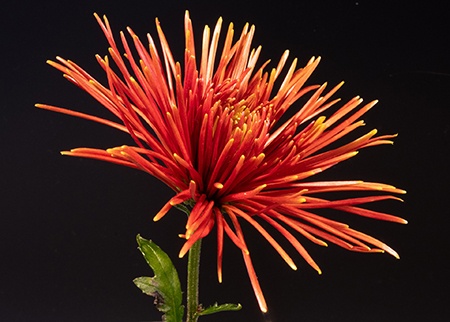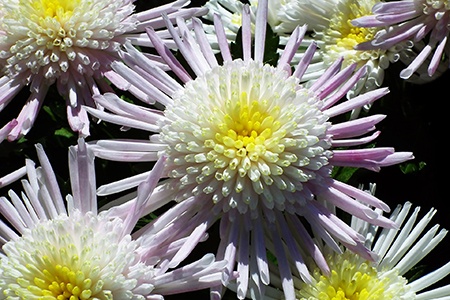14 Types of Chrysanthemum to Spruce Up Your Flower Bed
Author: Jen Worst | Editor: Omar Alonso
Review & Research: Jen Worst & Chris Miller

Next to roses, the various types of chrysanthemum flowers are the most popular in the world. With 40 wild species and thousands of varieties, they come in many sizes, colors, and number of flowers per stem.
And these mums are good for the environment too, which means your home, inside and out. It is totally worth knowing a little more about these flowers, is it not? So, let’s dive in.
14 Types of Chrysanthemum
As a fan of these beautiful flowers, if you're in the USA you can join the National Chrysanthemum Society, with the equivalent in the UK as well.
Let's look at the most popular and readily available types of mums so you can pick the kind you prefer, both visually and for their other properities, such as being one of the plants that repel fleas.
Single Blooms

These mum varieties look a lot like daisies because they have white petals and yellow centers. But the difference is that chrysanthemums have a center that is a lot bigger than daisies and the petals are equally spaced around them.
A fully grown single bloom chrysanthemum mostly looks a bit bushy and grows about two to three feet tall. However, some of them are known to be no taller than a foot.
It is not uncommon to see only one petal per stem. But single blooms are capable of growing in clusters too. Common mum varieties include Bolero and Clara Curtis.
Some varieties look like a yellow and white daisy and are called Icy Isle while the ones that have a yellow center and red petals with yellow stripes are called Fire Island. You might also find semi-double mums which are quite appealing visually.
Quilled Blooms

Then there are chrysanthemum types that have spiky petals and look like a quill. These petals are also narrow and sometimes seem to cup up at the tip. The quintessential example is the Patricia Grace quill mum.
These petals are usually described to look like a spoon because of their edge. Mum varieties like Lola are large in size and have lonely lavender petals whereas the Kings Delight variety while being large has a shade of pink on them.
These types of chrysanthemum have an open tip and no open enter. Some varieties of mum like Toffee grow about six inches tall and are good for disbuds.
Spider Blooms

This variety of chrysanthemum have long and thin petals that look like spider legs. Hence the name. They are long and tub like but the petals can go in many different directions which makes them look very elegant.
Varieties like Evening Glow have rose or bronze-colored petals while Symphony is lacy and has petals that come in bronze or yellow color. You will also find white-colored chrysanthemums which are also classified as spider blooms.
Then there is the Chesapeake variety which grows six inches tall and has petals that range from fine to coarse. These chrysanthemum types can have hooks or coils at the end of their petals like Cremon or Anastasia.
In fact, the chrysanthemum Green Anastasia is a unique flower because of its lime green color. The petals tend to curl at the tips and there is no defined center. They grow three to five inches in diameter and need full sun and well-drained soil to grow well.
Anemone Chrysanthemums

The central part of these chrysanthemums is like a disk and the petals are all around it. Some petals could be in the shape of a tube which gives them a cushioned look.
For example, there is a variety called Angel which has a yellow center and lavender-colored petals which give it the cushioned look. The outer petals are a bit large and usually come in dark purple color with the tips being white. Chrysanthemum colors are what it's all about!
These chrysanthemums grow up to four inches in height and are perfect as a disbud. Daybreak and Mansetta Sunset are good examples of this type of mums. The yellow ones are Anderton anemone mums.
Pompon Chrysanthemums

Pompons have globe-shaped heads and short petals that hide their disk. When they have small heads, they are called button chrysanthemum varieties.
If you find one with a solid white-colored bloom, you are looking at the Moonbeam variety. These grow up to two to three inches in height.
If the bloom is small and very green in color, you are looking at a Yoko Ono. That is correct. In the beginning, Pompons are flat but as they mature, the blooms are almost four inches wide.
Lakeside is a good example. Types of chrysanthemum flowers like Baby Tears and Small Wonder are best put to use in sprays, especially since they're one of the plants that repel spiders, indoors and outdoors.
Decorative Blooms

These types of mum flowers come in many sizes and their petals cover their disks. Some decorative blooms have a short bloom and come with petals that curve towards the inside of the flower.
If you see a chrysanthemum that is smaller than usual and has bronze petals with a dark center, you are looking at Lexy. But if you are looking at a medium-sized bloom that has amber-colored petals, that is Honeyglow. These go well in a flower bed along side any types of lantana flowers as well, due to the color similarities.
These chrysanthemums like Indian Summer and Tobago usually grow five inches tall or higher and can be grown in a pot. The Coral Charm mums are a beautiful pink that everyone should try to grow.
Incurve Blooms

Like decorative blooms, these chrysanthemum types have petals that curve inwards. If you find chrysanthemums that have large heads and petals that are irregularly shaped, you are looking at incurve blooms.
They are also inconsistent and informal visually. Goldfield, with its golden yellow color, is a good example. These chrysanthemums usually grow six to eight inches tall.
They also look like a ball and are compact which makes them attractive. If you are looking at a mauve and lavender-colored chrysanthemum, it is called Moira.
These are also known as intermediate curve types of chrysanthemum and look small and fluffy. Then there is a French variety called St. Tropez and it has bright red petals with bronze-colored tips.
Reflex Chrysanthemums

If you are looking at a chrysanthemum with a flat center and overlapping petals which curve downward, that is a reflex chrysanthemum. You can say these are the opposite of incurve chrysanthemum because their petals grow outwards.
If you are looking at petals that droop away from the center, it is a reflex chrysanthemum specifically called Joyce Fountain. The petals are red in color and there is a little bit of yellow in the center. They also have an intermediate curve.
These blooms are in the shape of a globe and grow four to five inches wide. They are usually light or dark orange in color but that is not a rule. Reflex chrysanthemums also grow up to six inches in height and have a flat bloom.
Brush or Thistle Chrysanthemums

These chrysanthemums have petals that are tube like and fine. They grow parallel to the stem and usually have a diameter that is no more than two inches.
The petals look flat and droopy but you might see them look like a paint brush sometimes. These are very small and are great when used in sprays, since these are also plants that repel ticks among other insects.
Spoon Chrysanthemums

These look like semi-double chrysanthemums but the petals look like a spoon at the tip. That is very close to the quilled mum look but they are not the same.
These chrysanthemums have a visible and round center disk. Some varieties like Kimie grow up to four inches tall and are great as a disbud. They are also used in sprays and can act as a natural spider repellent.
The Starlet spoon mum is a sight to behold, as well as the Happy Face mums. These chrysanthemum types look like little suns and stars that grow up in groups, in either white or yellow colors.
Cushion Chrysanthemums

These mums look quite bushy but maybe because they do not grow very tall. A fully-grown cushion chrysanthemum is still quite close to the ground and produces wide masses of blooms.
They are medium-sized and if you see names like Valor, Chiffon and Ruby Mound, you are looking at a cushion chrysanthemum types of mums.
Unclassified Chrysanthemums

Despite the fact that there are thousands of mum varieties, there are some that do not fall into any one category. These are usually about six inches wide and the petals look large and quite exotic.
Resemblances with other varieties are quite natural (as you might have already realized). On varieties like The Lone Star, you might find the petals to be a bit twisted.
Chrysanthemum Superbum Alaska

This one, also known as Shasta Daisy, grows in zones five to nine and is usually about three feet tall. These are white chrysanthemums that bloom in July and August.
They need full sun and well-drained soil to grow well. But they can tolerate dry soil, are deer resistant and they attract butterflies.
Chrysanthemum Creamist Golden

This is a cultivar with a big and bright yellow bloom. It blooms during the fall and when it matures, it reaches about three and a half feet tall.
These chrysanthemum varieties also require full sun. And while they can grow in any type of soil, it thrives in clay or sandy soil because they are well drained.
Types of Chrysanthemum for Every Preference
Chrysanthemums are beautiful flowering plants that are actually native to east Asia and northeast Europe. A lot of them originate in China but as the above list demonstrates, there are a lot of cultivars and horticultural varieties.
In fact, they are believed to be cultivated in China around the 15th century BC as a flowering herb. Since then, many cultivars were grown and by 2014, more than 20,000 cultivars are said to exist across the globe.
In the world of art, these are known as Four Gentlemen and have been significant during the Double Ninth Festival, celebrated in the ninth month on the Chinese calendar.
All of the various types of chrysanthemum are undoubtedly beautiful flowers with an incredible history.



